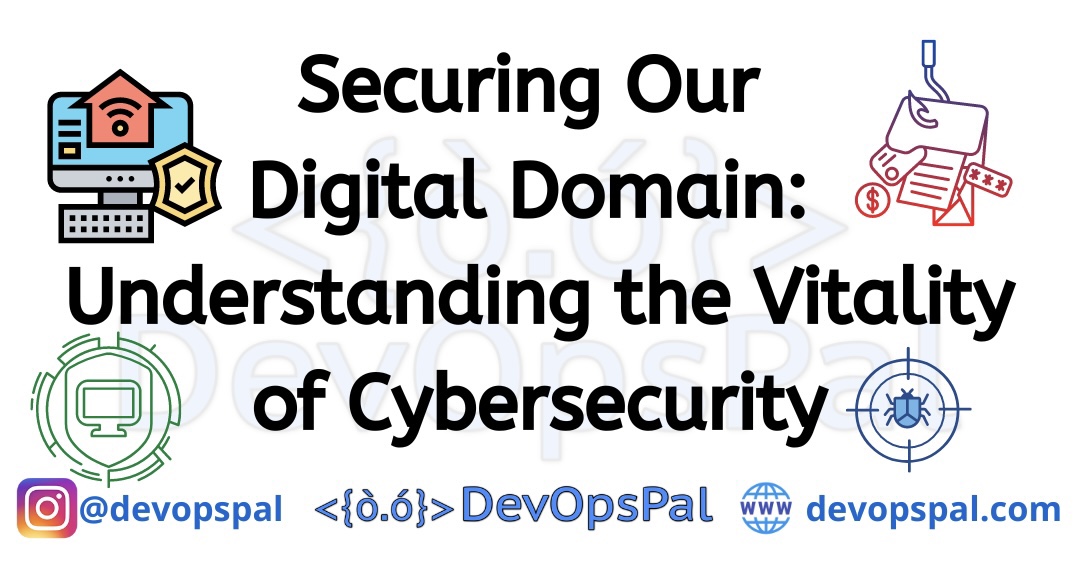Introduction:
In today’s interconnected world, where technology has become an integral part of our daily lives, cybersecurity has emerged as a crucial concern. With the increasing reliance on digital systems, the potential risks and threats to our personal information, businesses, and even national security have escalated significantly. In this blog post, we will delve into the realm of cybersecurity, exploring its importance, common threats, and proactive measures to safeguard our digital world.
The Significance of Cybersecurity:
Cybersecurity encompasses a range of practices, technologies, and processes designed to protect computers, networks, and data from unauthorized access, damage, or theft. It is vital for several reasons:
- Protecting Personal Information: In the era of digital transformation, personal information is a valuable asset. Cybersecurity measures help safeguard sensitive data such as social security numbers, financial records, health information, and personal communications from falling into the wrong hands.
- Safeguarding Businesses: Cyber attacks on businesses can have devastating consequences, leading to financial losses, reputational damage, and even bankruptcy. Robust cybersecurity measures are essential to protect valuable corporate data, trade secrets, and intellectual property from cybercriminals seeking unauthorized access.
- Ensuring National Security: Governments across the globe face significant cybersecurity challenges, as critical infrastructure, military systems, and sensitive government data are at risk of cyber attacks. Protecting national security requires robust cybersecurity practices to safeguard classified information and prevent potential disruptions or attacks on crucial systems.
Common Cybersecurity Threats:
To effectively protect ourselves and our digital assets, it is important to understand the common cybersecurity threats we face:
- Malware and Ransomware: Malicious software, such as viruses, worms, Trojans, and ransomware, poses a significant threat. These programs can infect computers or networks, compromising data integrity, stealing sensitive information, or encrypting files until a ransom is paid.
- Phishing Attacks: Phishing is a deceptive technique used by cybercriminals to trick individuals into revealing sensitive information or clicking on malicious links. These attacks often occur via emails, text messages, or fake websites designed to appear legitimate, aiming to gain access to usernames, passwords, or financial details.
- Data Breaches: Data breaches occur when unauthorized individuals gain access to sensitive data stored by organizations. These breaches can lead to identity theft, financial fraud, or reputational damage. Weak security practices, insider threats, or targeted cyber attacks can result in large-scale data breaches affecting millions of individuals.
Proactive Measures for Cybersecurity:
While the threat landscape continues to evolve, there are proactive steps we can take to enhance cybersecurity:
- Strong Passwords and Multifactor Authentication: Create strong, unique passwords for each online account and consider using a password manager to securely store them. Enable multifactor authentication whenever possible, adding an extra layer of security by requiring additional verification beyond passwords.
- Regular Software Updates: Keep your operating systems, applications, and antivirus software up to date. Software updates often include crucial security patches to address vulnerabilities that cybercriminals may exploit.
- Phishing Awareness: Be cautious when clicking on links or opening attachments in emails, especially from unknown sources. Look for signs of phishing, such as suspicious email addresses, spelling or grammatical errors, or requests for personal information.
- Secure Wi-Fi Connections: Use secure, encrypted Wi-Fi connections, particularly when accessing sensitive information or conducting financial transactions. Avoid using public Wi-Fi networks that may be vulnerable to hackers.
- Backup and Recovery: Regularly back up important data and files to an external hard drive or a secure cloud storage service. In the event of a cyber attack or system failure, having backups ensures you can restore your information without significant disruption.
- Employee Training and Awareness: Organizations should prioritize cybersecurity training for employees to promote a culture of security. Educating employees about common threats, best practices, and the importance of data protection can significantly reduce the risk of cyber attacks.
Conclusion:
As our reliance on technology deepens, prioritizing cybersecurity is no longer optional; it is an imperative. By understanding the significance of cybersecurity, being aware of common threats, and adopting proactive measures, we can help protect our personal information, businesses, and critical infrastructure. Safeguarding our digital world requires a collective effort from individuals, organizations, and governments to stay one step ahead of cybercriminals and ensure a secure and resilient digital future.

